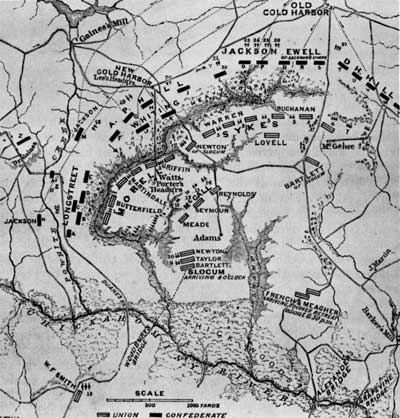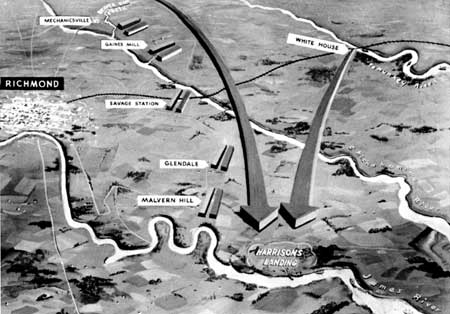|
RICHMOND National Battlefield Park |
 |
PART ONE
THE PENINSULA CAMPAIGN, SUMMER, 1862
(continued)

Battle of Gaines' Mill.
From Battles and Leaders of
the Civil War.
Gaines' Mill
The tactical situation was now extremely critical for both Lee and McClellan. Because of the repulse at Beaver Dam, Lee had not yet achieved his first objective, which, according to his battle order, was to "drive the enemy from his position above New Bridge," about 4 miles east of Mechanicsville. Lee's whole plan for the defense of Richmond, in the event McClellan should elect to march on the city with his main force south of the Chickahominy, hinged on his ability to cross the river quickly and attack the Federal rear. Lacking control of New Bridge this would be impossible. Although the Union position behind Boatswain Swamp was actually east of New Bridge, the approaches to the bridge could be covered by Porter's artillery.
The situation was equally serious for McClellan. With Jackson enveloping his right flank and rear, and believing he "had to deal with at least double" his numbers, White House would have to be abandoned. Having made the decision to change his base to the James, he desperately needed time to perfect the arrangements and to get the thousands of wagons and the herd of cattle safely started. His order to Porter was explicit, "hold our position at any cost until night * * *."

McClellan's change of base.
Painting by Sidney King.
Porter's corps now occupied a semicircular line of battle along the crest of the partially wooded plateau behind Boatswain Swamp, with both extremes resting on the Chickahominy River. It was another naturally strong position further strengthened by felling trees and digging rifle pits. The approaches to the position were over an open plain and across a sharp ravine. Gen. George Morell's division held the left and Gen. George Sykes' right, with McCall's weary troops in reserve. Gen. Philip St. George Cooke's cavalry was on Porter's extreme left, in the lowlands bordering the Chickahominy. During the course of the impending battle of Gaines' Mill, Porter would be reinforced by Gen. Willard Slocum's division, giving him a total strength of about 35,000, as opposed to about 60,000 for Lee.
On the Confederate side, Longstreet was on Lee's right opposite Morell, A. P. Hill in the center, and Jackson and D. H. Hill on the left. Lee was convinced that the greater part of the Federal army was in his front, and he still thought McClellan would try to protect his base and retreat toward White House. On these erroneous assumptions he made his plans.
A. P. Hill would attack the center while Longstreet made a feint on the Union left. Then when Jackson appeared on the Union right, Lee believed Porter would shift part of his troops to meet Jackson's threat in order to keep him from getting between the Union army and its base at White House. As soon as Porter did this, Longstreet would turn the feint into a full assault, and together with Hill drive the Union forces into Jackson and D. H. Hill, waiting on Lee's left.
About 2:30 p.m. Hill attacked the center of the Federal line, but under a devastating fire of artillery and musketry, "where men fell like leaves in an autumn wind," his troops were hurled back with heavy losses. Longstreet, realizing a feint now would not help Hill, ordered a full-scale attack, but he too suffered a bloody repulse. Jackson, sensing that "Porter didn't drive worth two cents," as he quaintly put it, threw D. H. Hill against Sykes on Porter's right.
By now A. P. Hill's division was badly cut up, and on Lee's request Jackson sent Whiting's division, consisting of Gen. E. M. Law's and John B. Hood's brigades, over to support him. Porter then threw in Slocum's division of Franklin's corps, to protect threatened points along the line. The vicious battle waged furiously for 4 hours. "The noise of the musketry," said one veteran, "was not tattling, as ordinarily, but one intense metallic din."
Finally, just as darkness covered the bloody field, Hood's Texas brigade, along with Gen. George Pickett's brigade on Longstreet's left, penetrated the right of Morell's line in a courageous bayonet charge that broke the morale of the Federal troops. They went streaming back across the plateau to the safety of the Chickahominy River. In a last desperate attempt to stem the tide, General Cooke ("Jeb" Stuart's father-in-law) sent his cavalry in a wild charge against the pressing Confederates. But the retreating Union infantry and artillery obstructed the cavalry and broke its attack. The only result was the loss of several more artillery pieces in the confusion.
With darkness closing in and the Confederate troops disorganized after the breakthrough, Lee did not attempt to pursue the Federals farther. Porter withdrew the remnants of his corps across the river and rejoined the main Union army. Total casualties in this crucial battle, the most costly and vicious of the Seven Days, were: Union, 6,837; Confederate, 8,751.
In a sense, both sides had achieved their immediate objectives. Porter had held until night, so McClellan could get his army safely started for Harrison's Landing. Lee had cleared the north side of the Chickahominy of all Federal forces, broken their supply line to White House, controlled strategic New Bridge, and had turned back McClellan's advance on Richmond.

|

|
|
Last Modified: Mon, Mar 4 2002 10:00:00 pm PDT |


